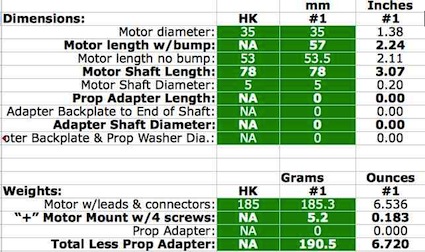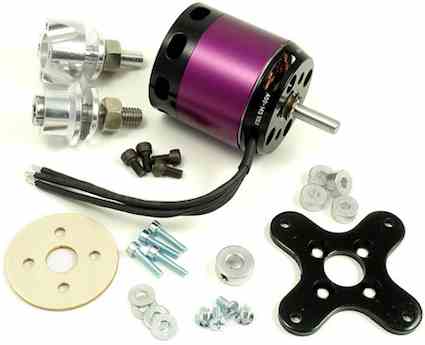 |
Flying High With Electric Power!
The Ampeer ON-LINE!
Fly the Future - Fly Electric! |
Site Table of Contents
| President: | Vice-President: | Secretary/Treasurer: |
| Ken Myers | Richard Utkan | Rick Sawicki |
| 1911 Bradshaw Ct. | 240 Cabinet | 5089 Ledgewood Ct. W. |
| Commerce Twp., MI 48390 | Milford, MI 48381 | Commerce Twp., MI 48382 |
| (248) 669-8124 | (248) 685-1705 | 248.685.7056 |
 | ||
| Board of Directors: | Board of Directors: | Ampeer Editor |
| David Stacer | Arthur Deane | Ken Myers |
| 16575 Brookland Blvd. | 21690 Bedford Dr. | 1911 Bradshaw Ct. |
| Northville, MI 48167 | Northville, MI 48167 | Commerce Twp., MI 48390 |
| 248.924.2324 | 248.348.2058 | 248.669.8124 |
| Mailed Ampeer printed subscriptions are no longer available.
The Ampeer is FREE on-line in Acrobat .pdf format and HTML with active links! | ||
| The Next Meeting:
Date: Thursday, April 11Time: 7:30 p.m. Place: Ken Myers' house, Commerce Twp., MI 48390 | ||
| What's In This Issue? | ||||
| Review of Hobby King's Turnigy G25 710Kv Outrunner, Ken Myers tests and reviews this motor. | Upcoming Keith Shaw Birthday Party Electric Fly-in 2013 - Info and map for this upcoming event. | |||
| The February EFO Meeting, Roger Wilfong shares his little Rivets and a giant Lazy Bee, Richard Utkan shares his 'Or What', Hank Wildman shares a retract he's working on for his airliner, and Ken Myers showed the members how to gather data for insertion into Drive Calculator using Jim Young's Hacker A50-12S. | Motor Review: Hacker A50-12S V2 Outrunner, Ken Myers tests this motor with specifications given and prop recommendations. The EFO members, at the February meeting, also helped with the collection of the data. | |||
| Announcing the 29th Annual Mid-America Electric Flies, links to the Flyer and map and hotel info for the 2013 Mid-Am. | ||||
|
By Ken Myers Dave Stacer loaned me a Turnigy G25 710Kv outrunner to test and add to the Drive Calculator database. The motor has now been added to the current Drive Calculator database. Dave did not supply a prop adapter, so there is no information on it in the specifications and weights. I do not take motors apart to inspect their construction, but the exterior was nicely finished. It has a 5mm shaft diameter, which is good for this size motor. The first table shows the supplier's data and the second table is a comparison between the supplier's data and measured data. 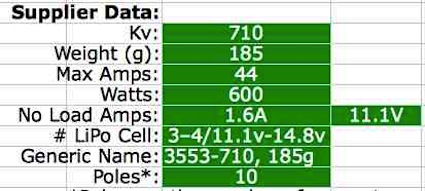
The specifications from Hobby King, the supplier, are in the HK column and the measured data in the other columns. Hobby King states that the Kv is 710. It was measured as 738 using a drill press and mathematical calculations and Drive Calculator calculated a Kv of 740. Generically it is a 3554-740, 185g. It is a 10 pole motor. The number of poles is important when using a phase tachometer, which attaches to the motor leads to 'read' the RPM, using devices such as the Hyperion Emeter 2 or Eagle Tree Systems eLogger. To clarify what poles are, Eagle Tree Systems notes:
If you are uncertain about the number of poles, or want to verify you calculated correctly, a hand-held tachometer can be used to compare the RPM value displayed real-time by your recorder, in a bench test (assuming it is safe for you to do this). Real-time display is available in Recorder USB Live Mode, on the eLogger PowerPanel, or with the Seagull Wireless Dashboard. (This had to be done for this motor. KM) If the value displayed is incorrect, you can change the poles setting to adjust the displayed RPM value. For example, if your handheld tachometer reads 4000 RPM, and your Eagle Tree data shows the maximum RPM of 8000, you would need to double the number of poles to "2"." The Eagle Tree Web site for the brushless rpm Sensor. The last table shows Drive Calculator ESTIMATES for the approximate performance at an elevation of 287m or 940 ft. AMSL and a temperature of 24-deg C or 75-deg F. Always use a power meter to determine whether the prop is appropriate for the elevation and temperature it will be used at. In general, lower elevations and ambient temperatures raise the amp draw! |
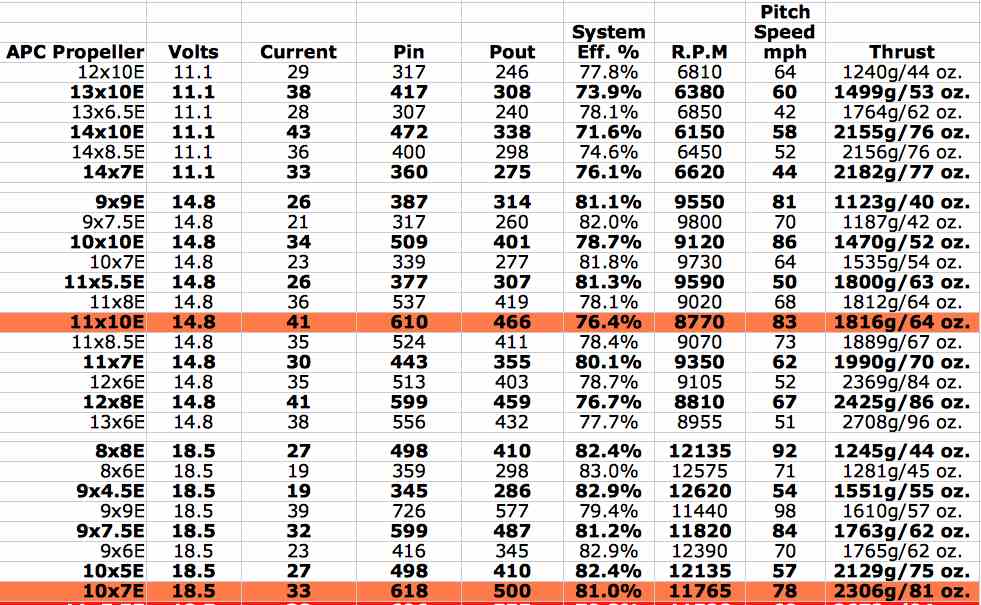
|
Note: The 11x10E prop with a 4S LiPo pack and the 10x7E prop used with a 5S LiPo pack exceed the recommended maximum motor watts in of 600, as recommended by the supplier. Four and five cell "A123" 2300mAh packs would be appropriate for use with this motor. The Pin/watts in, estimated thrust and pitch speed from the table suggests the power system's application. This motor is also supplied with a supplier's stated Kv of 610 and 870. 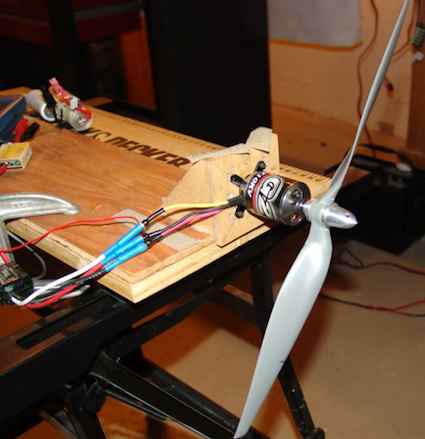
The G25 on the test stand Upcoming Keith Shaw Birthday Party Electric Fly-in 2013 The Balsa Butchers will once again be hosting the "Keith Shaw Birthday Party Electric Fly-In" at their field near Coldwater, MI. The event will take place on June 8 and 9, 2013. Contest Director: Dave Grife - E-mail: grifesd@yahoo.com or Phone: 517.279.8445
The Flying Field will be open Friday, June 7 for early arrivals Saturday, June 8, hours are from 9 a.m. 'til 5 p.m.
Landing Fee is $10 for the weekend. Directions: Quincy is approximately 4.5 miles east of I-69. Clizbe Road is approximately 1.6 miles east of Quincy. The Flying site is approximately 1.5 miles south of US-12 on the west side of Clizbe Road. |
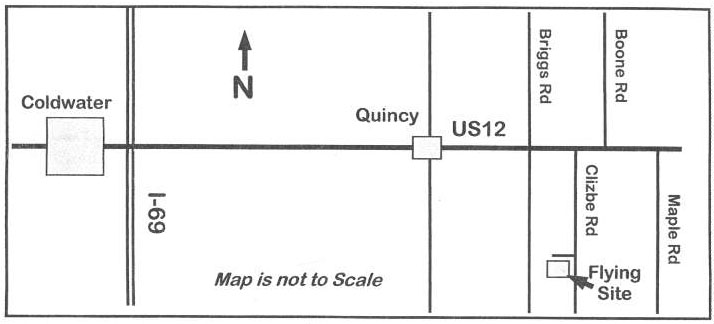
|
The meeting was held on the evening of February 14 at Ken's house. Several current projects were shared. Roger Wilfong, brought along a couple of projects. The first one he shared was his GM Glasscraft Rivets. It is a neat, little, go fast plane. 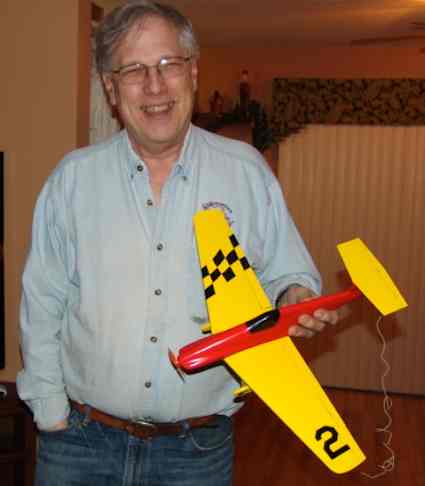 His second plane was a giant Lazy Bee purchased at a swap shop. He thought it was nicely done with a silk covering and that he could recover the fuselage with silk and dope, since the wing looked pretty good when he bought it. Unfortunately, it was not to 'bee'. He ended up having to recover the whole model. It is powered with an Astro Flight brushless geared motor and 5 "A123" 2300mAh cells. 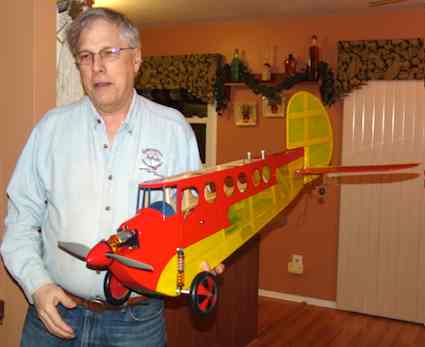 Richard Utkan, EFO vice-president brought his Walt Mocha 'Or What'. It has a 60-inch wingspan and a wing area of 675 sq.in. It weighs in at 4.5 lb. (72 oz.). It is powered by an Astro Flight 25 geared and 5 "A123" 2300mAh cells. 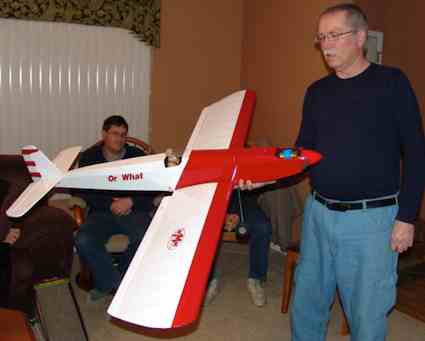 Hank Wildman shared his latest project. He demonstrated his retracting gear unit that he intends to put in his EDF airliner. 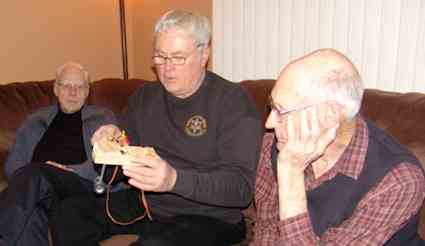 After the show and tell, Ken Myers took the folks to his basement to demonstrate how he collects motor data for input into Drive Calculator. Jim Young brought the motor. It was a Hacker A50-12S that he is planning on using in his Skybolt bipe with a 6S Li-Po pack. After the data gathering and demonstration on how to use the collected data, the members enjoyed some refreshments. Motor Review: Hacker A50-12S V2 Outrunner
Lynn Morgan, a fellow flier at the Midwest RC Society, flies this motor in his Osiris pattern plane using a 5S Li-Po, Castle Phoenix Ice Lite 100, and PT Models 16x10E Carbon prop. He reports 1550 static watts in at wide open throttle near the beginning of the battery discharge. I've watched him fly this plane for a long time and have been very impressed by the power. I asked him to send me one of his recent Ice 100 Lite data files from the logging ESC. I was interested in how much over the "rule of thumb" of 3 watts in per gram of motor weight he was running this motor. It's a lot, but that's another story for another time. Jim Young needed to replace his Astro Flight 40G brushed motor in his Skybolt biplane. He decided to use this motor with a 6S LiPo. He brought his motor to the February EFO meeting where we collected the data using it to input into Drive Calculator. The motor is nicely produced. It comes with an excellent choice of hardware including; a collet type prop adapter, bolt-on prop adapter, "+" mount and assorted screws, nuts and bolts. The motor may be mounted to a forward mount with the 'can' rotating behind it or on the "+" mount with the 'can' rotating in front of it. The mounting options, with the included hardware, make for very versatile installations! While doing some motor research, I recently ran across this quote on RC Groups. "Unfortunately there are a lot more "motors" than ""testers with the appropriate test equipment". Since manufacturers data (if any exist) are often unreliable and don't include the necessary parameters anyway, the only way a motor becomes useful to DriveCalc is if someone tests it extensively.... even in DriveCalc, some motors are there simply because someone entered the manufacturer's Io, and maybe no-load rpm! Cheers, Phil" Phil is known as Dr Kiwi on RC Groups. This motor certainly adds credence to his statement. Compare the information provided by Hacker for these two motors; the A50-12S V2 492Kv and the A50-14S V2 425Kv. |
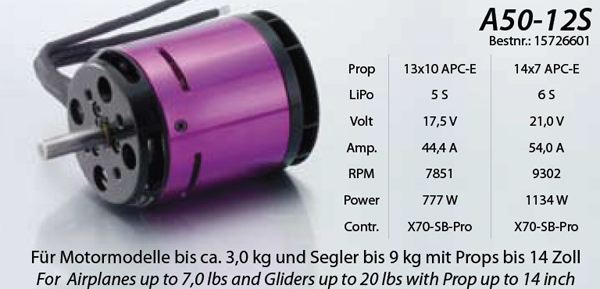
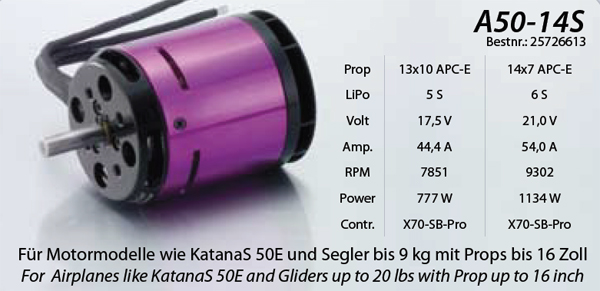
Not only did the 'manufacturer' not get it right, the US importer's specifications are extremely 'odd'. The importer is Aero-Model, Inc. Aero-Model is also known as Hacker Brushless USA and www.hackerbrushless.com. 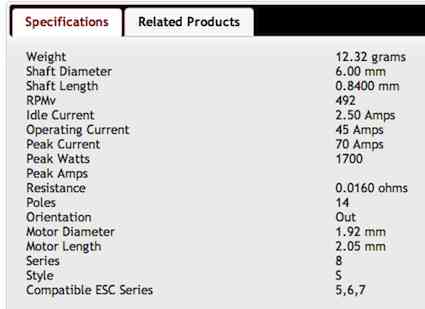 Aeromodel's data for the Hacker A50-12S
Aeromodel's data for the Hacker A50-12SAnother USA supplier is Esprit Model. The Esprit Model specifications are located at www.espritmodel.com/hacker-a50-s-series-motors.aspx. 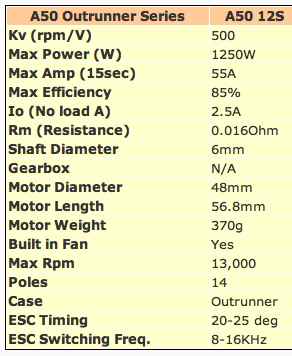 When using the supplied data from all three sites, it is very difficult to determine how to use this motor safely. Hacker in Germany does not give a continuous amp or burst amp rating. They hint that 70 amps might be the maximum by noting that it requires a 70-amp ESC. Aero-Model states, "Operating Current 45 Amps" and "Peak Current 70 Amps". Esprit Model states that the maximum amp draw for 15 seconds is 55 amps. Hacker and Esprit Model indicate that the maximum power is 1250 watts in, but Aero-Model states 1700 watts in. Keep in mind that Lynn Morgan has been running his motor, with no problems, for a long time and many, many flights at a static maximum of 1550 watts in. His data log shows that he very seldom reaches that peak during his pattern routine. Weights and Measures: 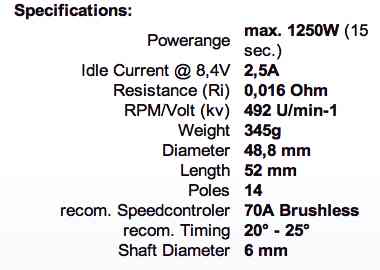 The specifications on the Hacker Germany Web site showed a motor weight of 345g. The motor in hand weighed 373g with its leads and three 4mm bullet connectors. The drill press measured and calculated Kv was 507.6 and Drive Calculator calculated 506.9, once the collected data was input. The Hacker site suggested 20-deg to 25-deg of timing. The Castle Creations Ice 50 used in the data gathering was set to low/0-deg timing. The correct Hacker A50-12S generic name (can diameter mm, can length mm, dash Kv, wt. in grams) is Hacker 4954-505, 370g. The first test was the Kv test using a drill press. Next an Emeter II was used to gather all the data, NOT the onboard data from the Castle Creations Phoenix Ice 50 amp ESC. Two no load runs were logged and averaged for the no load inputs into Drive Calculator. A 6S "A123" pack was used for one of the no load tests and a 6S Li-Po for the other test. The 6S Li-Po was used to gather the loaded data. Four props were logged, in this order, on the same battery charge, APC 10x7E, APC 11x7E, APC 12x8E and APC 13x8E. They were then averaged and used as the prop load inputs for Drive Calculator. The testing was done in the basement in Walled Lake, MI, USA.
Jim had hoped to use this motor with a Castle Creations Ice 50-amp ESC and an APC 13x8E prop. An APC 13x8E was the last one used for data gathering and was recorded at 21.37v (3.56v per cell), 48.5 amps and 9377 RPM. With Drive Calculator inputs of 22.2v and a change of temperature to 24-deg C/75-deg F the prediction for the APC 13x8E is 22.2v, 49.3A and 9692 RPM. This could be okay with Jim's 50-amp ESC, but I suggested that he might want to try an APC 13x6.5E first. Drive Calculator, set to 75 degrees F and our elevation, predicts an amp draw in the low to mid-40s and an RPM in the neighborhood of 9900. This yields a pitch speed of about 61 mph, which is plenty fast enough for this biplane. In a phone conversation with Keith Shaw a few days later, he suggested an APC 14x7E, if prop clearance allows. Drive Calculator, at our elevation and 75-deg F predicts 22.2v, 54 amps and 9570 RPM. Actual power meter testing should be done with this prop and then it's up Jim whether he wants to push his ESC or not. A report on what prop Jim Young decides to use will be in an upcoming issue of the Ampeer, once the weather breaks here in southeastern Michigan. With the data for this motor now in Drive Calculator, various battery and prop combinations can be tried at elevations and temperatures appropriate to where and how the motor will be used. The prop chart was created using Drive Calculator set for our elevation here in southeastern Michigan, 287m and a temperature of 24-deg C/75-deg F. As always, a power meter is a must before deciding to fly any given prop. The prop chart is ONLY a guide. Hacker implied the use of a 5S or 6S Li-Po battery by noting 17.5v and 21.0v in their examples. |
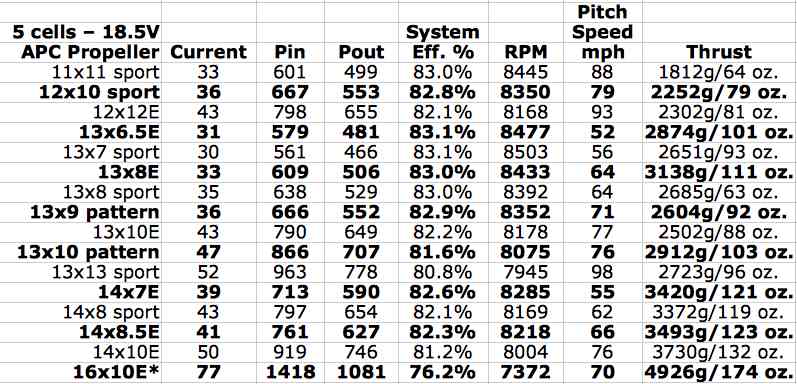
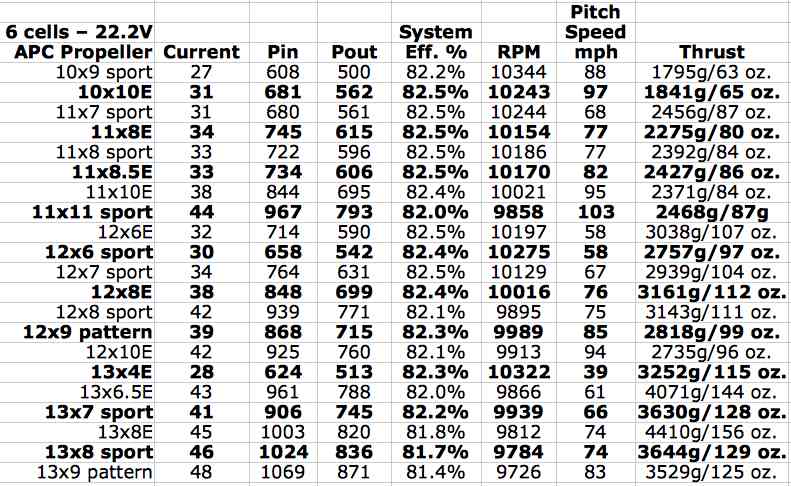
| An APC 16x10E was noted with an asterisk in the 5S example props. It is there to 'represent' Lynn's 16x10 carbon prop and to show that these examples should be on the conservative side.
I have created prop charts for 4S, 7S and 8S Li-Po batteries that MIGHT work without over taxing the motor. Again, if you decide to go out of range, be sure to use a power meter and be willing so suffer any consequences. |

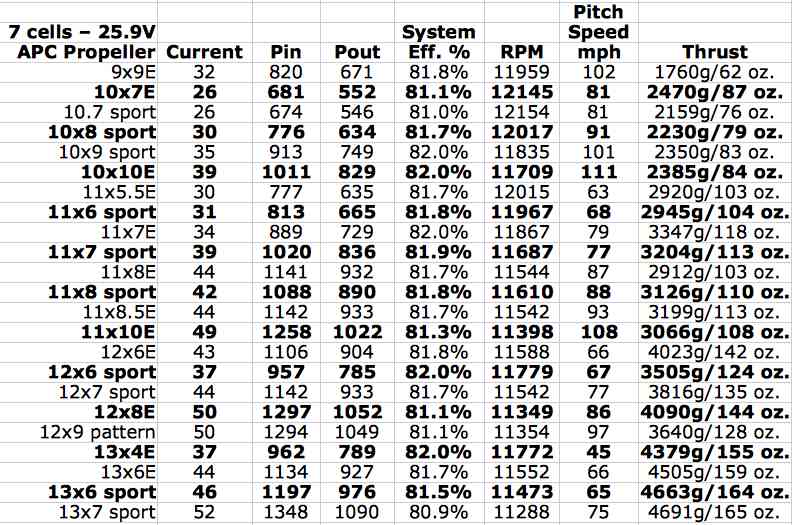
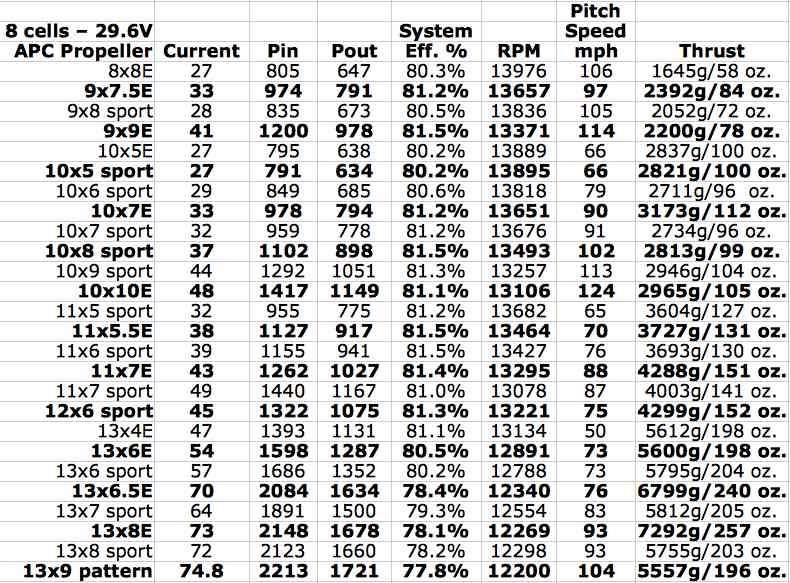
| I have been using O.S. Motor outrunners recently, and have had good success with them.
After looking this Hacker A50-12S over and testing it, I think I may be adding some Hacker Outrunners to my fleet soon. I was very impressed with the complete hardware package and especially having both the bolt-on and collet type prop adapters provided. 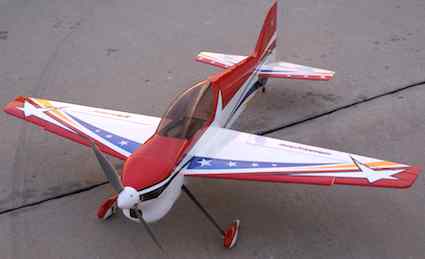 This is a photo of the Osiris pattern plane designed by Andrew Jesky and previously mentioned. The equipment recommended by Andrew at the 3D Hobby Shop Web site works very well in it. Announcing the 29th Annual Mid-America Electric Flies Here are the links to the 2013 Flyer as well as the field map and local area hotels list. 2013 Map to the flying field and local hotels listing |
To Reach Ken Myers, you can land mail to the address at the top of the page. My E-mail address is: KMyersEFO@theampeer.org
